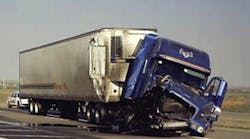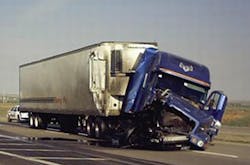Most jobs in the United States are fairly safe. From receptionist, to retail, to healthcare and beyond, most occupations are not considered hazardous since there is a minimal risk of personal injury while on the job.
But, if you’re like any of these workers, the chance for injury or death skyrockets due to terrible working conditions and risky environments. According to the Bureau of Labor Statistics, these jobs stack up as some of the most dangerous jobs in America.
Next time you punch into work, just think: you’re at least warm, comfortable and safe. Not like these guys. Here are the riskiest jobs in America:
Fishing
You’re cold. You’re wet. It’s dark. And you’ve got days left at sea with a small bed to sleep in and cold food to hold you over. Fishermen get the short end of the stick when it comes to occupational hazards. And it isn’t just the environment that stinks. Unfortunately, fishermen in the United States have the highest fatality rate for a profession due in part to malfunctioning gear, rough seas, bad weather and faulty watercraft. At just over $25,000 in average annual salary, the job sails in rough waters.
Fatality rate: 116 per 100,000 workers
Logging
The logging industry is known for high fatality rates in America. In 2010, the industry saw an increase from 36 to 50 occupational fatalities from the year prior resulting from accidents involving blunt force. Loggers have to endure a tough environment in often-inclement weather. Coupled with high altitudes, the combination can be deadly. Loggers are paid an average of just under $33,000 a year.
Fatality rate: 91.9 per 100,000 workers
Aircraft Personnel
While rumor has it that air travel is the so-called safest mode of transportation, the same urban myth does not hold true for aircraft personnel. Transportation accidents including aircraft crashes make this occupation a dangerous choice. While airline pilots get paid considerably more than other dangerous professions (ranging from the high $70s to over $100,000), the job does not come without considerable risks including injury and death.
Fatality rate: 70.6 per 100,000 workers
Farming
Working and tending to a farm is hard work and often a 7-days-a-week kind of job. Because many farmers operate heavy machinery, including large vehicles and engines, the occupation is risky. The majority of fatalities result from tractor accidents, machinery malfunction and even livestock, which can attack farmers when they least expect it. At an average yearly salary of just under $70,000, a farmer or rancher must decide if the occupation outweighs the risk of injury associated with the job.
Fatality rate: 41.4 per 100,000 workers
Mining
Mining has a long track record of occupational fatalities that result from heavy machinery, explosives, dust and tight quarters. Every so often, mining accidents make unfavorable headlines for multiple occupational deaths when something goes awry such as equipment failure or trapping by way of explosions. Miners can expect to make anywhere from $37,000 to $89,000 a year.
Fatality rate: 19.9 per 100,000 workers
Roofing
A roofer’s job is not easy. Unfortunately, falls are the major contributor to occupational deaths in roofing. There are hundreds of injuries reported from roofing as well, from broken bones to fractured hips and beyond. An average roofers’ salary is $34,000.
Garbage Collecting
You would think that collecting garbage, while stinky, is not very dangerous. But statistics tell us otherwise. Due to lacerations and other catastrophic injury, garbage collectors have a fatality rate that rivals some of the most dangerous jobs in the country. And at an average annual salary of $34,000, this job is one of the worst in America.
Fatality rate: 29.8 per 100,000 workers
Truck Driving
There’s no doubt that truck drivers are subjected to some of the most unpleasant working conditions. From long hours, traffic and poor weather all are leading contributors to car accidents, injury and even wrongful death. Truck drivers have the largest volume of occupational fatalities of all jobs. A truck driver can expect to make anywhere from $29,000 to $37,000 per year.
Fatality rate: 21.8 per 100,000 workers
Stuntman
It’s not just Hollywood special effects. Stuntmen have some of the most dangerous jobs in America. Just last year, a stuntman on “The Hangover Part II” suffered a brain injury in one of the industry’s worst accidents in many years. Stuntmen do get paid more than other dangerous jobs, but the risk involved certainly makes the pay less attractive.
Fatality rate: 2.5 per 1,000 workers
Law Enforcement
The police have their work cut out for them. From the obvious dangers stemming from guns and other violence, police hold one of the most dangerous jobs in the United States. With a 40 percent increase in police fatalities since 2009, nearly half of these deaths occurred as a result of car accidents.
Fatality rate: 18 per 100,000 workers
Michael Pines founded the Law Offices of Michael Pines, APC, in San Diego in 1992. He is an accident and injury prevention expert in San Diego, and he is on a campaign to end senseless injury one blog at a time.

